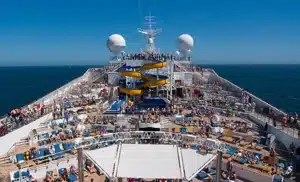By Chris Insall, Head of Maritime Market Development, ST Engineering iDirect
QoS. It’s the holy grail for any cruise operator. Successful cruise lines are built upon exceptional customer experience. That’s the food and drink, the entertainment, the surroundings – and let’s not forget the all-essential connectivity.
A year or so after COVID restrictions were finally dropped, the bounce back of cruise can now be quantified – and it’s good news. In CLIA’s 2022 report, The State of the Cruise Industry, 80% of travelers who have cruised before say they will cruise again – that’s the same percentage as before the pandemic. Since cruising restarted in 2020, 5 million passengers have sailed, and 86 countries have reopened to cruise lines. And the future is looking very bright. Passenger volume is expected not just to recover, but to exceed 2019 levels by the end of 2023. The report goes on to say that passenger volume is projected to recover in excess of 12% above 2019 levels by the end of 2026.
With the cruise industry on the cusp of a boom time, the customer experience is going to be more critical than ever and a big part of that is the connectivity available to them on board the ship. A reliable and quality broadband service is now a key differentiator for any cruise line operator. A typical family cabin is home to up to five devices and each one will consume a considerable amount of bandwidth. Passenger expectations are high. They won’t tolerate downtime, they don’t want the movie they’re streaming to buffer. They want to share video footage of their experience with friends and loved ones. Therefore, the Quality of Service offered by service providers must be first-class.
Quality – Guaranteed
Operators expect an SLA that includes 100% CIR (Committed Information Rate) as a baseline and with a very high level of availability, usually 99 or 99.5%. This defines the proportion of time that the CIR is available. There are other factors to consider such as jitter and round trip. There can be many ships in any region at any one time, and each ship will have different bandwidth demands, but the operators need to ensure that bandwidth is consistently made available to all contracted ships. When 4000 people on board a ship all demand varying amounts of bandwidth, there can be no question of patchy service availability. But there are several elements that come together to create the advanced mobility that’s needed to enable service providers to offer the very highest quality, reliable connectivity that cruise operators must have access to.
An advanced approach
ST Engineering iDirect offers various waveforms to address a variety of use cases but our latest innovation is Mx-DMA MRC which brings forth the full scalability of TDMA return technologies to the same SCPC-like efficiency that mobility networks require. The MDM5010 modem has smashed the speed barrier, becoming the industry’s fastest VSAT modem for shared bandwidth networks, delivering increased levels of performance and enhanced Quality of Experience (QoE).
The next critical component of advanced mobility is an NMS capability specifically designed to support mobility networks which enables easy management of a complex network that covers tens of thousands of terminals across different gateways, satellites and beams. This is especially important in terms of mobility, as the service provider must be able to manage dynamic traffic efficiently.

We’re also now seeing networks that have heterogeneous user requirements with a mix of ships, which results in wide variation of terminal types and throughput requirements per terminal. The ability to be able to manage all of those different types of throughput and antenna performance requirements within a single network is a key differentiator for service providers.
One such provider that has fully embraced advanced mobility is satellite operator, Eutelsat. The company is a key player in the provision of satellite connectivity to cruise ships and has deployed ST Engineering iDirect’s Dialog® platform.
For Eutelsat, this is an expanding market and therefore, advanced mobility has an important part to play in enabling the company to meet the stringent requirements of cruise customers. Paul Petit-Jean, Head of Maritime Business Line, Connectivity Business Unit at Eutelsat stated: “Eutelsat continues to show strong momentum in providing high-speed, quality Internet services to major Cruise ships in the Mediterranean and Caribbean Sea, with key partners such as Telenor Maritime, via their global Dialog-enabled ADVANCE Services; in addition, we also see recent expansion into new passenger growth sectors such as Expeditionary Cruise.”
Multi-orbit and 5G
Software defined satellites enable service providers with flexible capability to deliver coverage and capacity anywhere and in real-time. Delivering this level of orchestration is a brand-new requirement for the market, and definitely something that we as a ground infrastructure provider must support.
As with other segments, there is keen interest in upcoming NGSO constellations, but also on enhanced terrestrial connectivity, considering that cruise ships spend much of their time in port or within range of cellular networks. The telco world is moving toward the 5G mobile standard, which will be a universal architecture integrating every form of access technology into one common network. The cruise sector is also adopting critical IT advances like standardization, virtualization, and orchestration to improve the speed, scale, cost, and flexibility of service delivery. This will facilitate a multitude of use cases on board and given that a cruise ship is essentially a floating city, this is essential to retain passenger loyalty and to cope with daily operations. The satellite industry must adopt these standards to better integrate with these networks to deliver consistent quality of services across multiple access networks and orbits.
The complete package
Whilst there are new players emerging to serve the mobility market, VSAT-based connectivity remains the most reliable and consistent means of delivery of satellite services for communications providers. In a sector where QoS is integral, a suite of advanced mobility capabilities is essential for any operator.
